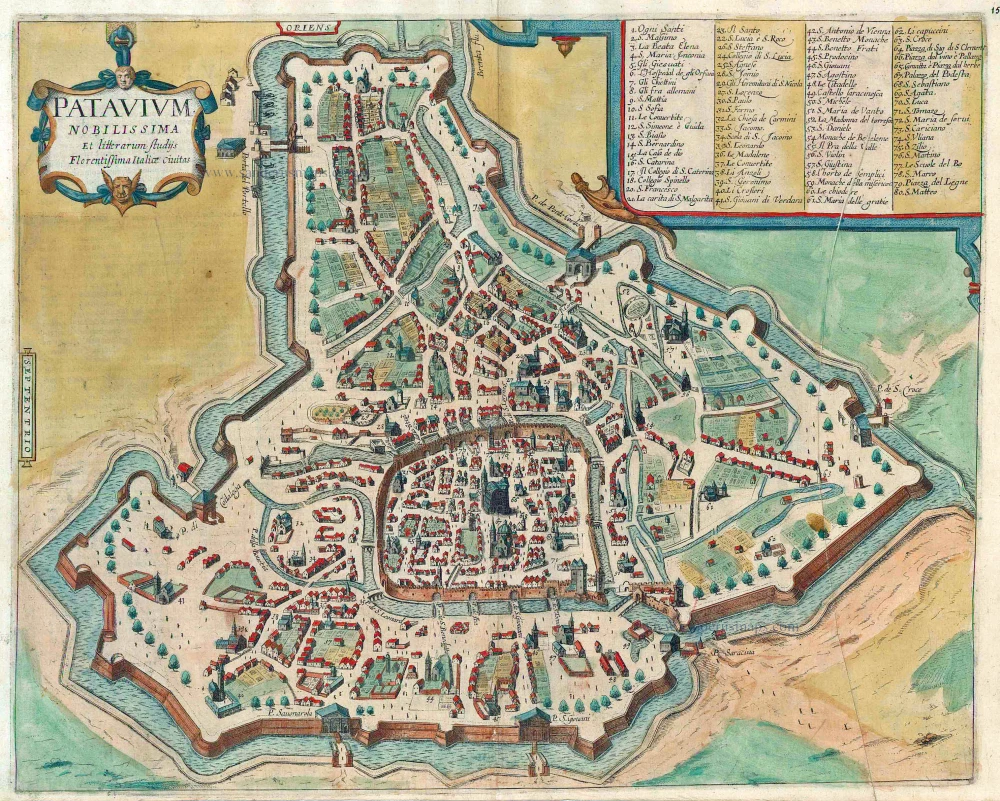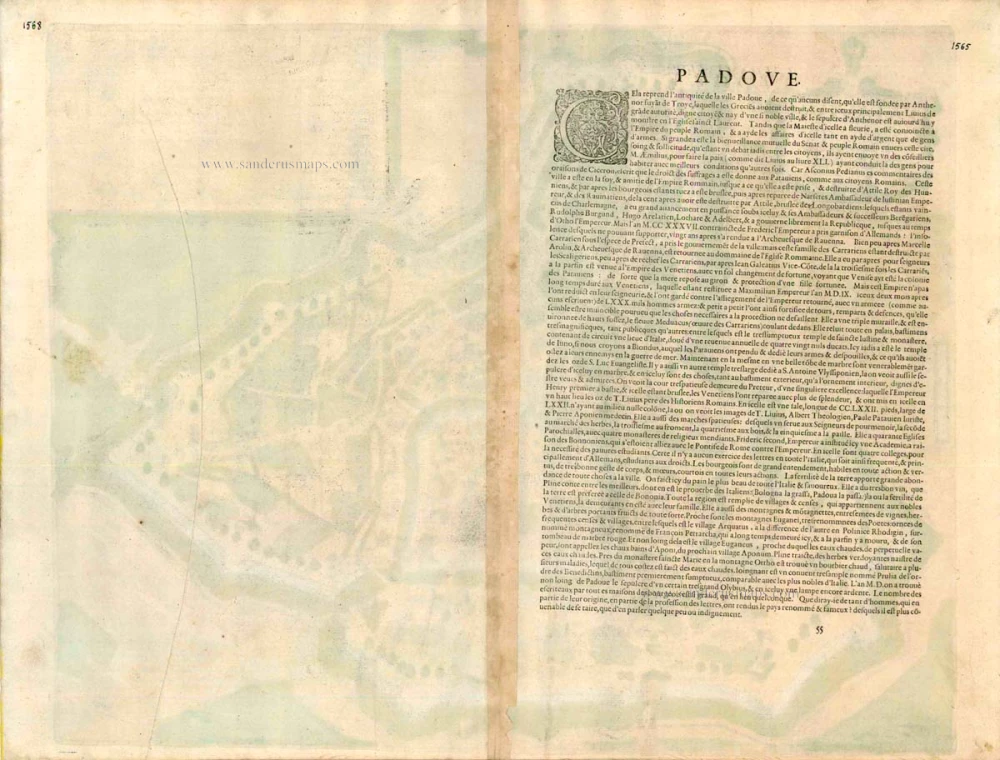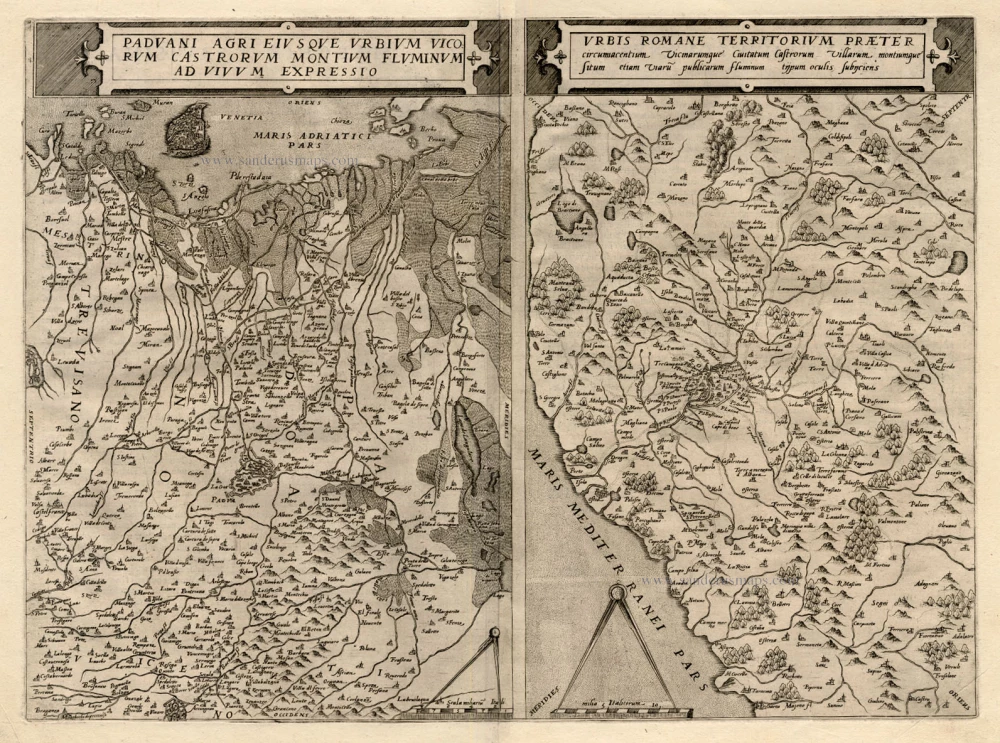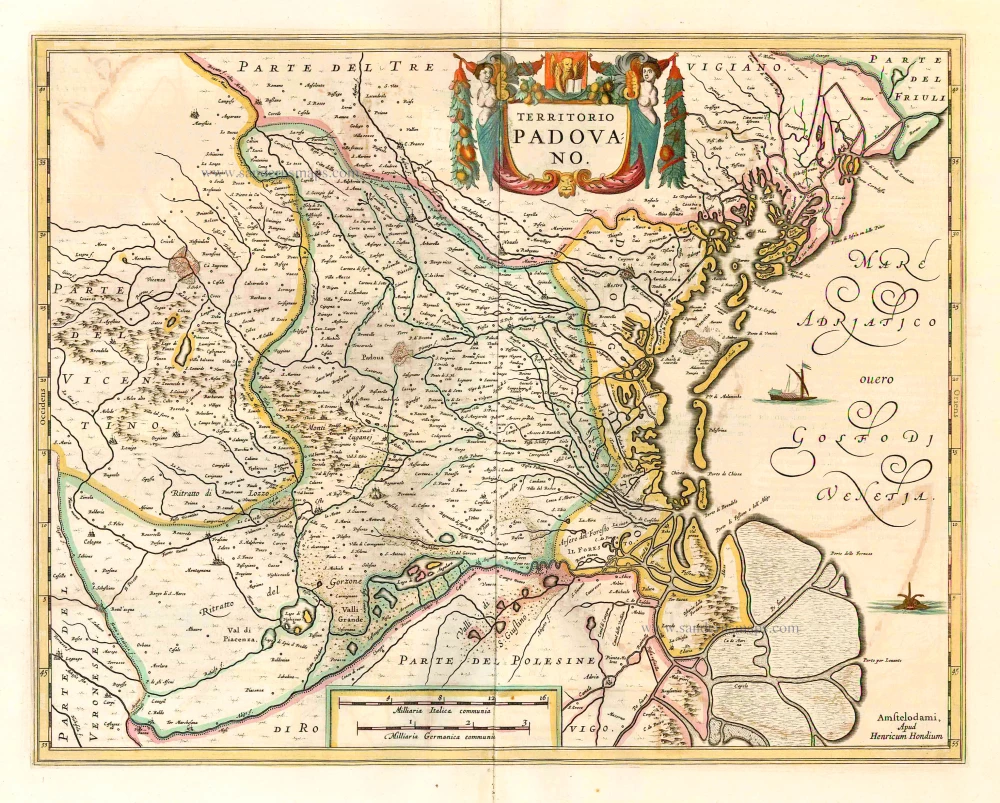Padua (Padova) by Georg Braun & Frans Hogenberg c. 1625
TRANSLATION OF CARTOUCHE TEXT: Padua is a renowned city in Italy and a flourishing centre of the sciences.
COMMENTARY BY BRAUN (on verso): "That Padua is a very old town can be seen from the fact that it is said to have been built by Antenor, a Trojan who came to Italy after the destruction of his home town. ... Finally, it came under the rule of the Venetians. How strange is the course of this world, for Venice was originally a foundation of the burghers of Padua, meaning that the mother's head was now lying in her daughter's lap. But the latter was happy to protect her and stood firmly by this commitment. However, the Venetians did not remain in possession of the city long and were forced to hand it over to Emperor Maximilian and the Empire in 1509, but seized it again two months ago."
The most striking feature of this bird's-eye view of Padua from the west is the city wall and moat, built by the Venetians in 1509. The medieval heart of the city, also surrounded by a wall and moat, contains the town hall and the cathedral, and outside this is the monastery church of Santa Giustina (57) with the tomb of St Lucas, located in the present-day Prato della Valle, the church of St Anthony with the saint's tomb (32) is inconspicuous. The Langobardi (Lombards) destroyed the ancient city in AD 601 and rebuilt it in the late 8th century. At the beginning of the 12th century, Padua became a free commune. In 1164, it joined the Lombard League. In 1222, Frederick II founded Italy's third university. It is one of the most famous in the country, and such celebrated scholars as Galileo Galilei worked here. (Taschen)
Braun G. & Hogenberg F. and the Civitates Orbis Terrarum.
The Civitates Orbis Terrarum, also known as the 'Braun & Hogenberg', is a six-volume town atlas and the most excellent book of town views and plans ever published: 363 engravings, sometimes beautifully coloured. It was one of the best-selling works in the last quarter of the 16th century. Georg Braun, a skilled writer, wrote the text accompanying the plans and views on the verso. Many plates were engraved after the original drawings of a professional artist, Joris Hoefnagel (1542-1600). The first volume was published in Latin in 1572 and the sixth in 1617. Frans Hogenberg, a talented engraver, created the tables for volumes I through IV, and Simon van den Neuwel made those for volumes V and VI. Other contributors were cartographers Daniel Freese and Heinrich Rantzau, who provided valuable geographical information. Works by Jacob van Deventer, Sebastian Münster, and Johannes Stumpf were also used as references. Translations appeared in German and French, making the atlas accessible to a broader audience.
Since its original publication of volume 1 in 1572, the Civitates Orbis Terrarum has left an indelible mark on the history of cartography. Seven more editions followed the first volume in 1575, 1577, 1582, 1588, 1593, 1599, and 1612. Vol.2, initially released in 1575, saw subsequent editions in 1597 and 1612. The subsequent volumes, each a treasure trove of historical insights, graced the world in 1581, 1588, 1593, 1599, and 1606. The German translation of the first volume, a testament to its widespread appeal, debuted in 1574, followed by the French edition in 1575.
Several printers were involved: Theodor Graminaeus, Heinrich von Aich, Gottfried von Kempen, Johannis Sinniger, Bertram Buchholtz, and Peter von Brachel, all of whom worked in Cologne.
Georg Braun (1541-1622)
Georg Braun, the author of the text accompanying the plans and views in the Civitates Orbis Terrarum, was born in Cologne in 1541. After his studies in Cologne, he entered the Jesuit Order as a novice, indicating his commitment to learning and intellectual pursuits. In 1561, he obtained his bachelor's degree; in 1562, he received his Magister Artium, further demonstrating his academic achievements. Although he left the Jesuit Order, he continued his studies in theology, gaining a licentiate in theology. His theological background likely influenced the content and tone of the text in the Civitates Orbis Terrarum, adding a unique perspective to the work.
Frans Hogenberg (1535-1590)
Frans Hogenberg was a Flemish and German painter, engraver, and mapmaker. He was born in Mechelen as the son of Nicolaas Hogenberg.
By the end of the 1560s, Frans Hogenberg was employed upon Abraham Ortelius's Theatrum Orbis Terrarum, published in 1570; he is named an engraver of numerous maps. In 1568, he was banned from Antwerp by the Duke of Alva and travelled to London, where he stayed a few years before emigrating to Cologne. He immediately embarked on his two most important works, the Civitates, published in 1572 and the Geschichtsblätter, which appeared in several series from 1569 until about 1587.
Thanks to large-scale projects like the Geschichtsblätter and the Civitates, Hogenberg's social circumstances improved with each passing year. He died as a wealthy man in Cologne in 1590.
Patavium Nobilissima et litterarum studijs Florentissima Italiae Civitas.
Item Number: 16648 Authenticity Guarantee
Category: Antique maps > Europe > Italy - Cities
Padua (Padova) by Georg Braun & Frans Hogenberg.
Title: Patavium Nobilissima et litterarum studijs Florentissima Italiae Civitas.
Date of the first edition: 1617.
Date of this map: c. 1625.
Copper engraving, printed on paper.
Size (not including margins): 385 x 485mm (15.16 x 19.09 inches).
Verso: French text.
Condition: Original coloured, faint printers' crease.
Condition Rating: A.
From: Théatre des Principales Villes de tout l'Univers Vol. VI. c. 1625. (Van der Krogt 4, 41:3.6)
TRANSLATION OF CARTOUCHE TEXT: Padua is a renowned city in Italy and a flourishing centre of the sciences.
COMMENTARY BY BRAUN (on verso): "That Padua is a very old town can be seen from the fact that it is said to have been built by Antenor, a Trojan who came to Italy after the destruction of his home town. ... Finally, it came under the rule of the Venetians. How strange is the course of this world, for Venice was originally a foundation of the burghers of Padua, meaning that the mother's head was now lying in her daughter's lap. But the latter was happy to protect her and stood firmly by this commitment. However, the Venetians did not remain in possession of the city long and were forced to hand it over to Emperor Maximilian and the Empire in 1509, but seized it again two months ago."
The most striking feature of this bird's-eye view of Padua from the west is the city wall and moat, built by the Venetians in 1509. The medieval heart of the city, also surrounded by a wall and moat, contains the town hall and the cathedral, and outside this is the monastery church of Santa Giustina (57) with the tomb of St Lucas, located in the present-day Prato della Valle, the church of St Anthony with the saint's tomb (32) is inconspicuous. The Langobardi (Lombards) destroyed the ancient city in AD 601 and rebuilt it in the late 8th century. At the beginning of the 12th century, Padua became a free commune. In 1164, it joined the Lombard League. In 1222, Frederick II founded Italy's third university. It is one of the most famous in the country, and such celebrated scholars as Galileo Galilei worked here. (Taschen)
Braun G. & Hogenberg F. and the Civitates Orbis Terrarum.
The Civitates Orbis Terrarum, also known as the 'Braun & Hogenberg', is a six-volume town atlas and the most excellent book of town views and plans ever published: 363 engravings, sometimes beautifully coloured. It was one of the best-selling works in the last quarter of the 16th century. Georg Braun, a skilled writer, wrote the text accompanying the plans and views on the verso. Many plates were engraved after the original drawings of a professional artist, Joris Hoefnagel (1542-1600). The first volume was published in Latin in 1572 and the sixth in 1617. Frans Hogenberg, a talented engraver, created the tables for volumes I through IV, and Simon van den Neuwel made those for volumes V and VI. Other contributors were cartographers Daniel Freese and Heinrich Rantzau, who provided valuable geographical information. Works by Jacob van Deventer, Sebastian Münster, and Johannes Stumpf were also used as references. Translations appeared in German and French, making the atlas accessible to a broader audience.
Since its original publication of volume 1 in 1572, the Civitates Orbis Terrarum has left an indelible mark on the history of cartography. Seven more editions followed the first volume in 1575, 1577, 1582, 1588, 1593, 1599, and 1612. Vol.2, initially released in 1575, saw subsequent editions in 1597 and 1612. The subsequent volumes, each a treasure trove of historical insights, graced the world in 1581, 1588, 1593, 1599, and 1606. The German translation of the first volume, a testament to its widespread appeal, debuted in 1574, followed by the French edition in 1575.
Several printers were involved: Theodor Graminaeus, Heinrich von Aich, Gottfried von Kempen, Johannis Sinniger, Bertram Buchholtz, and Peter von Brachel, all of whom worked in Cologne.
Georg Braun (1541-1622)
Georg Braun, the author of the text accompanying the plans and views in the Civitates Orbis Terrarum, was born in Cologne in 1541. After his studies in Cologne, he entered the Jesuit Order as a novice, indicating his commitment to learning and intellectual pursuits. In 1561, he obtained his bachelor's degree; in 1562, he received his Magister Artium, further demonstrating his academic achievements. Although he left the Jesuit Order, he continued his studies in theology, gaining a licentiate in theology. His theological background likely influenced the content and tone of the text in the Civitates Orbis Terrarum, adding a unique perspective to the work.
Frans Hogenberg (1535-1590)
Frans Hogenberg was a Flemish and German painter, engraver, and mapmaker. He was born in Mechelen as the son of Nicolaas Hogenberg.
By the end of the 1560s, Frans Hogenberg was employed upon Abraham Ortelius's Theatrum Orbis Terrarum, published in 1570; he is named an engraver of numerous maps. In 1568, he was banned from Antwerp by the Duke of Alva and travelled to London, where he stayed a few years before emigrating to Cologne. He immediately embarked on his two most important works, the Civitates, published in 1572 and the Geschichtsblätter, which appeared in several series from 1569 until about 1587.
Thanks to large-scale projects like the Geschichtsblätter and the Civitates, Hogenberg's social circumstances improved with each passing year. He died as a wealthy man in Cologne in 1590.






